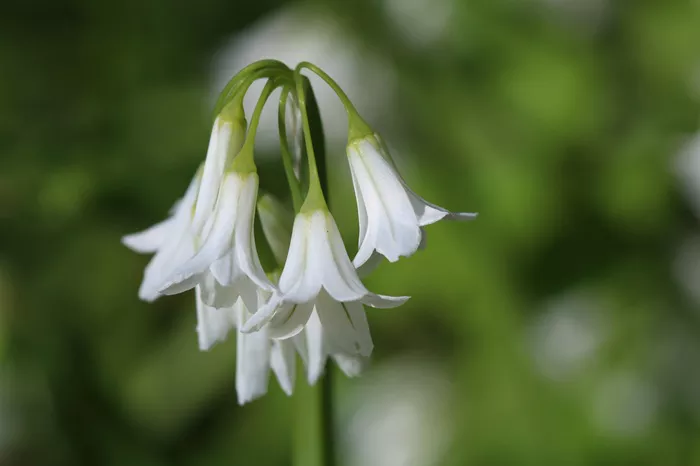In the heart of spring, when the world awakens from winter’s slumber, few sights are as enchanting as a carpet of bluebells. Yet, among these iconic purple blooms, a rare and delicate variant captures the imagination: the white bluebell. Often mistaken for an anomaly, the white bluebell is a marvel of nature, offering a serene contrast to its more common counterpart. This article delves into the world of white bluebells, exploring their origins, characteristics, and the unique allure they bring to gardens and woodlands alike.
The Origins and Botanical Background of White Bluebells
A Natural Variation or a Special Mutation?
White bluebells are not a separate species but rather a natural variant of the common bluebell (Hyacinthoides non-scripta). This charming plant is native to the British Isles and parts of Western Europe, where it thrives in woodland clearings and meadows. The white form appears sporadically within populations of bluebells, often as a result of genetic mutations. These mutations affect the production of anthocyanins, the pigments responsible for the bluebell’s characteristic purple hue. In white bluebells, the absence of these pigments reveals the pure, untouched white of the flower, making it a rare and sought-after sight in the wild.
Cultural Significance and Historical Lore
Throughout history, bluebells have been steeped in folklore and cultural significance. In Celtic mythology, bluebells were believed to be enchanted flowers that could summon fairies. The white bluebell, with its ethereal appearance, was often associated with purity and the spiritual realm. In some legends, it was said to bloom only in places where fairies had danced, adding an extra layer of mystique to its presence. In modern times, the white bluebell has become a symbol of hope and renewal, often featured in springtime festivals and celebrations.
Characteristics of White Bluebells
Flower Structure and Appearance
White bluebells share many of the same characteristics as their purple counterparts. Each flower consists of six delicate, bell-shaped petals that hang gracefully from a slender stem. The petals are slightly recurved, giving the flower a nodding appearance, as if it is bowing in reverence to the earth. The white color of the petals is striking, especially when contrasted against the green foliage of the forest floor. Unlike some other white flowers that can appear stark or clinical, the white bluebell has a soft, almost luminescent quality, making it appear as though it is glowing from within.
Growth Habits and Habitat Preferences
White bluebells are perennial plants, meaning they return year after year, bringing their delicate beauty to the same locations. They prefer partial shade and well-drained soil, often thriving in the dappled light of woodland edges or in meadows with occasional tree cover. In the wild, they can be found in deciduous forests, where the canopy provides just the right amount of light and protection. In gardens, they can be cultivated in similar conditions, making them an ideal choice for shaded borders or woodland gardens.
Cultivating White Bluebells in Your Garden
Choosing the Right Location
If you are fortunate enough to have white bluebells in your garden, it is essential to provide them with the right environment to thrive. Select a location that offers partial shade, such as under the canopy of a tree or in a shaded border. The soil should be well-drained and rich in organic matter, as white bluebells do not tolerate waterlogged conditions. Adding a layer of leaf mold or compost can help improve soil structure and provide the nutrients these plants need.
Planting and Care
White bluebells can be propagated through bulbs or seeds. If planting bulbs, do so in the fall, about 3 to 4 inches deep and 3 inches apart. This allows the bulbs to establish strong root systems before the winter. Water the bulbs well after planting, but avoid overwatering during the dormant season. In spring, as the leaves begin to emerge, water regularly to keep the soil moist but not waterlogged. Once the flowers have bloomed and the leaves start to die back, reduce watering gradually to allow the bulbs to enter dormancy.
Companion Planting
White bluebells look stunning when planted alongside other woodland plants. Consider pairing them with ferns, hostas, or other shade-loving perennials to create a naturalistic woodland effect. Their white flowers also make a striking contrast against the dark green foliage of evergreens or the bright blooms of spring bulbs like daffodils and tulips. In a mixed border, white bluebells can add a touch of elegance and tranquility to the overall design.
The Conservation of White Bluebells
Threats to Their Survival
Despite their beauty, white bluebells, like many other wildflowers, face numerous threats in the wild. Habitat loss due to urbanization and agricultural expansion has reduced the natural range of these plants. Additionally, the introduction of non-native species, such as the Spanish bluebell (Hyacinthoides hispanica), can lead to hybridization and competition for resources. These hybrids often outcompete the native white bluebells, further endangering their survival.
What Gardeners Can Do to Help
Gardeners play a crucial role in the conservation of white bluebells. By choosing to grow native species in their gardens, they can help preserve the genetic diversity of these plants. Avoiding the use of chemical fertilizers and pesticides can also create a healthier environment for white bluebells and other native plants. Additionally, participating in local conservation efforts, such as habitat restoration projects or seed collection initiatives, can make a significant difference in the long-term survival of these delicate flowers.
Conclusion
White bluebells are a rare and enchanting treasure of the natural world. Their delicate beauty and serene presence make them a cherished addition to any garden or woodland. By understanding their origins, characteristics, and cultivation needs, we can better appreciate and protect these unique flowers. Whether you encounter them in the wild or nurture them in your garden, white bluebells offer a glimpse into the magic of nature, reminding us of the simple yet profound joys that flowers can bring to our lives.


